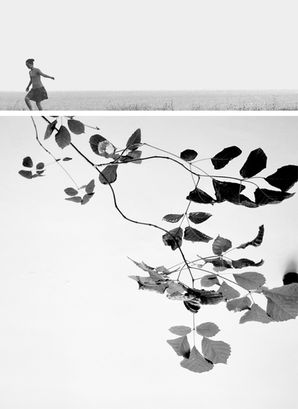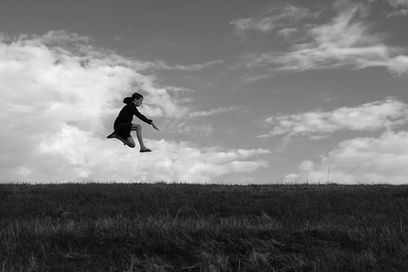
THE STREET IS A CACTUS
October 12, 2020
INTERVIEW
PHOTOGRAPHY Hakim Boulouiz
INTERVIEW Melanie Meggs
Are you fascinated by the art of capturing moments in the urban sprawl? Do you love to explore the chaotic yet beautiful spaces and uncover their hidden stories? Then you should meet Hakim Boulouiz, a professional photographer, writer and expert on urban aesthetics who lives and works in Geneva. He is passionate about cities, entranced by their order and disorder, and seeks to tell tales of poetry, paradox and mystery through his work. Drawing inspiration from colours, light, shadows, prints, walls and bodies, he believes that every ordinary moment can be transformed into an extraordinary one with patient observation, creativity and a lens.
To Hakim, street photography is a kind of visual recycling - like a sculptor forming shapes out of scrap metal or a designer giving waste new life. He believes beauty can be found everywhere, if you are willing to take the time to look. His favourite approach is to get up close to his subjects using a fixed wide-angle lens. He’ll show you how to see, how to take your time and believe in your art.
Join us as we explore Hakim Boulouiz’s incredible journey through the streets, discovering the ephemeral language of each city fragment and casting light on how even the most mundane things can be made extraordinary.

“The best painter of a cactus is the one who forgets that he is drawing a cactus, focusing only on the lines, shadows and shapes. This one will have the fairest, strongest, most sincere cactus because the artist puts aside his prejudices and decides to simply look at the thing in front of him. You have to do the same with the street. The street is a cactus!”
IN CONVERSATION WITH HAKIM BOULOUIZ
THE PICTORIAL LIST: Hakim please tell us about yourself. When did you start getting interested in photography?
HAKIM BOULOUIZ: I'm a professional photographer and an expert in urban aesthetics based in Switzerland. After receiving a diploma in architecture, a diploma in film-making, and a master's degree in land planning, I completed a PhD at the University of Geneva, analysing the mutual inspiration between urban modernity and the art of short film. Besides that, I have written a book about that, "Désirs de rue" published recently by MétisPresses, under Voltige libre Collection.
TPL: Where do you find your inspiration to create?
HB: I find inspiration on a terrace of a café that I don't know, in meditation, in nature during a walk in search of mushrooms. I find inspiration when I'm stuck in traffic jams, or when I'm talking with very old people near the entrance of a supermarket. I also find inspiration online, on Tik Tok, on Behance, by reading an autobiography, trying something new: a new dish, a new language...The most important thing is to have the courage to note ideas which pass like a flash. Believe me, it's this discipline which will make the difference! Creative people are methodical and well organised people, contrary to popular belief. The draft mind only gives the beginning of a sentence that remains endless.
TPL: Is there anything you want to express through your photography? And what are some of the elements you always try to include in your photographs?
HB: I would like to express surrealism. My goal is to make the surreal from the real. The surrealist image, would have an anchorage in the concrete and would in this way be able to express the surrealist that emerges from the everyday. Surrealist image is not anti-realistic, but takes its departure from the real in order to express real fantasies by unreal images. Surrealism is not a mechanical description that reflects reality as it is, but it is an artistic work that does not ignore reality. The surreal image passes from the man seen in his exterior, to the man seen in his interior. Surreal photography does not revolutionise, it subverts, that is to say, it does not reverse the classical images, it breaks them to install new ones. It is in this way creative. The sublime (and not the beautiful) is no longer the prerogative of enchanted forests, but is found at the corner of every street, in the layout and wear of cities. It is, therefore first an experience of existence and afterwards transcribed in an artistic form. I consider this photographic surrealism not a school in itself, but rather a way of being, a way of doing things. It is a concept, an interpretation of the elements of the city and its contents.
TPL: Do you have any favourite artists or photographers you would like to share with us, and the reason for their significance?
HB: I analyse, of course, the work of some great photographers, living and dead, but I also nourish my approach by other forms of expression, such as poetry and short literature. Cinema inspires me enormously, especially German Expressionism, young independent Asian cinema and Pier Paolo Pasolini. However, painting remains essential in photography. I love Magritte, Caravaggio, Brueghel, etc. They remain great masters for all visual arts.
TPL: Where is your favourite place to photograph?
HB: When I go somewhere, my first goal is to be able in the end to build a complete series about something special. Of course, it's not always possible, but it's important to think like that to stay motivated. In general, I'm looking to photograph the usual and unusual life (that's what I call 'street'). It can be outside or inside. I love crowded places because they can be very inspiring for my kind of work. I'm always looking for colours, contrast, layers, action, movement, markets, celebrations, fascinating characters and bizarre scenes. I have no preference of place or cities, everything is possible everywhere. Sometimes there are places that are theoretically very good, but if you are there at the wrong time of the day under bad light, or with equipment that is not adequate for the situation, it is of no use to you and you've wasted the day.
The urban scene is full of paradox: friendly and dangerous, beautiful and ugly, cheerful and sad. Through photography, I seek to raise questions about the fragility and the complexity of human life inside that paradox.

TPL: Do you prefer to photograph alone or with friends?
HB: It all depends on friends...and contexts. The problem is when I photograph I stop talking and I'm in full concentration! So, if I'm with friends whom I haven't seen for a long time, I prefer not to take pictures, so to take advantage of their presence (it's the minimum of politeness). It is very difficult to find the right friends to photograph the street with. This is because we do not all have the same walking rhythms and the same tastes for the different places. One of the solutions is to go on our own ways and make regular appointments every hour or 45 minutes, for example.
TPL: How does the equipment you use help you in achieving your vision in your photography? Do you have a preferred lens/focal length?
HB: My biggest challenge while on the street is to be able to get closer to the subject (I believe on immersion with it). I use both analogue and digital cameras, but only with fixed lenses of 28mm, 35mm, 50mm and 85mm. Sometimes with two cameras, like a war photographer in a peaceful place, and also for being rapid while working. I am very sensitive to the size of the camera I use. The size determines the style. The best cameras are the ones you can carry with you everywhere, so you are always ready to grab the moment. For beginners in street photography I recommend not a new camera but rather quite simply to make the decision to see the world again beyond its prejudices and to scrutinise it with a new eye which brings a new vision for the others. The best painter of a cactus is the one who forgets that he is drawing a cactus, focusing only on the lines, shadows and shapes. This one will have the fairest, strongest, most sincere cactus because the artist puts aside his prejudices and decides to simply look at the thing in front of him. You have to do the same with the street. The street is a cactus!
TPL: Have you ever been involved in the artistic world before photography?
HB: I have always been involved in fine art. When I was young I did a lot of drawing and painting. Then, I became an architect. During my studies I was in contact with several artistic expressions in the service of this discipline. Afterwards, I studied cinema and I became a film director...little by little I decided to professionalise myself in photography, this is where I am completely immersed today, and I find myself completely in this fascinating art.
TPL: Are there any special projects you are currently working on that you would like to let everyone know about?
HB: Today I photograph a lot commercially and at the same time I have long-term personal projects, such as Wax Dolls or Fresnel that I had started for a few years now. My goal is to release books from that with publishers, when the projects are finished, even if it never happens! Leonardo da Vinci said: "Art is never finished, only abandoned."
TPL: What are some of your goals as an artist? Where do you see yourself or hope to see yourself in five years?
HB: The urban scene is full of paradox: friendly and dangerous, beautiful and ugly, cheerful and sad. Through photography, I seek to raise questions about the fragility and the complexity of human life inside that paradox. The best image resides in an ability to convey moments of reflection to the man himself and clear a path that might make sense to him. My goal is to inspire the viewer and share with him a piece of the city and a piece of life. I'm a photographer because I would like to tell stories. I think photography is a fantastic medium for that. I'm a photographer because I would like to communicate beyond the barriers of languages and cultures. I am a photographer because I would like people to stop and think. I am convinced that powerful images can motivate the observer to ask questions and take actions that lead to changes. For me, this is the greatest goal of an artist, a utopia that motivates me every moment. In five years I see myself exhibiting more my work and showing it in several places, to give lectures and share my experiences with the public.
TPL: “When I am not out photographing, I (like to)…
HB: When I'm not making pictures, I like to listen to music, visit exhibitions, stroll in flea markets and I watch a good movie at least once a week, the cinema remains a very good visual training. I'm also a dad of a lovely little boy who is starting to amaze me with his questions and his own view of the world. I spend a lot of time playing with him. Now he also has his camera and I believe that we will soon start shooting together, if he agrees...Don't forget, freedom of choice is a very sacred thing, isn't it?”

Hakim Boulouiz is a photographer who is able to take ordinary moments and transform them into something extraordinary. By observing and capturing the order and disorder of cities, Hakim is able to tell stories of poetry and mystery. His work is a reminder to us that even the smallest things can be made special. If you're looking for an inspiring journey of creativity and self-discovery, explore Hakim's work by using the links below.
































